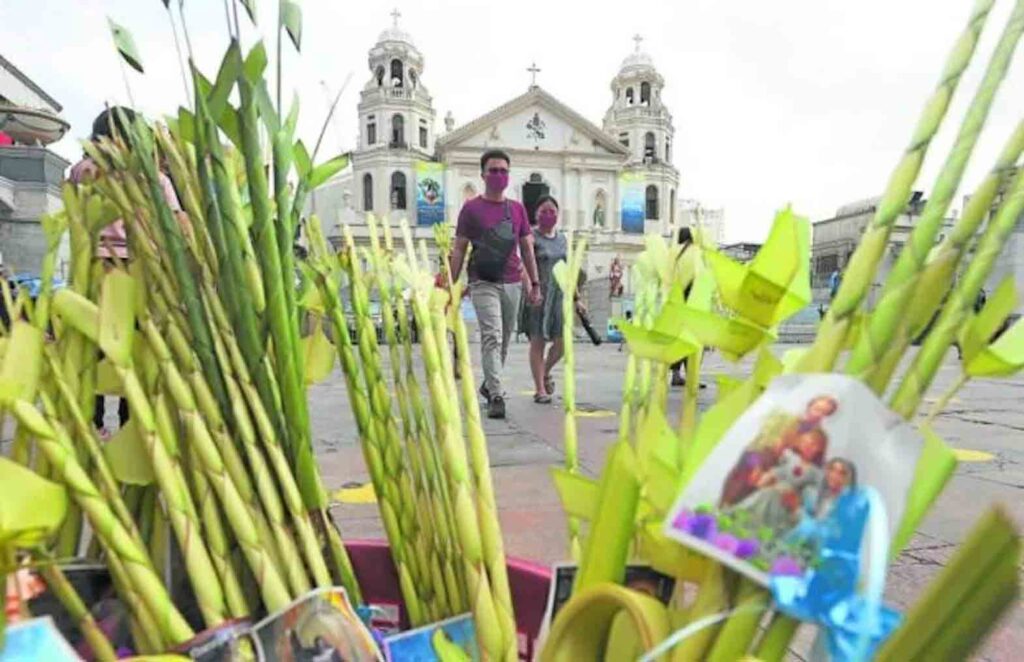Holy Week in PH: Crowded churches, mountains and beaches are back

The days of the Easter Triduum, from Maundy Thursday to Black Saturday, are considered statutory holidays. INQUIRER FILE
The previously announced half day of Holy Wednesday will afford all Filipino employees and workers to observe the solemn days leading to Easter. The days of the Easter Triduum, from Maundy Thursday to Black Saturday, are considered statutory holidays. Local television and most radio stations usually go off the air from Good Friday to Easter Sunday.
Businesses are closed and EDSA is empty. And the Christian world once again witnesses the uniqueness of the Filipino observance of the Holy Week (Spanish: Semana Santa; Filipino: Mahal na Araw). The Holy Week is the much-anticipated annual Christian occasion when Filipinos congregate at churches, processions, and Visita Iglesia.
On the other hand, people who visit churches during this period also see this as an opportunity for sightseeing and/or going to the beach.
All forms of air, land and sea transportation are busy. Every bus terminal and airport braces for the Holy Week surge. You’ll hear residents of Manila, Cebu and urban centers say, “We’ll go as far away as we can to get some fresh air and avoid traffic.”
Destinations include world-class beaches across the archipelago of seven thousand islands, from Aparri to Jolo. We recall that, during Holy Week prior to the Covid pandemic, for a lot of young Filipinos, mostly Catholics, a trip to Boracay, Puerto Galera, white beach, or pink beach meant a very long weekend of sin: Drinking and dancing until the sun came up.
The Pampanga government, but not the Church, has allowed the resumption of the public spectacle of self-flagellating penitents and Maleldo, the renowned Lenten tradition in the province highlighted by the reenactment of the crucifixion of Jesus Christ.
Imitatio Christi or the imitation of Christ is the highest act of adoration, and so most spectators wonder whether the annual Good Friday crucifixion in Cutud, Pampanga, is the highest form of the imitation of Christ, and therefore the highest act of adoration.
Visita Iglesia is the Catholic penitential tradition of visiting at least seven different churches during Holy Thursday and Good Friday. Most families who participate visit churches away from their hometowns. People participate in Visita Iglesia to share the same experience Jesus had during the crucifixion or have their wishes granted. There is a belief that people who complete all stations during Visita Iglesia will be rewarded.
True to the Filipino ingenuity, there has been a Bisikleta Iglesia since 2012, where the pilgrimage was made by bikes and motorbikes. The Filipino ingenuity takes this period of time as an annual opportunity for barkadas to be together and enjoy the Philippine sceneries outside the urban areas.
Suffice it to say that, for many Christians, the essence of Lent, particularly the observance of Holy Week, rests on Easter. The essence of the penitence, fasting, and prayers on Good Friday lies on the resurrection of Jesus. The most fundamental reason why they practice silence, give alms to others, avoid overexcited fun, and why they fast is this: Lenten sacrifice and death to oneself (mortification) lead them to the joy of Easter.
Hence, the most important of all processions for good Catholics is the Salubong, a unique tradition of the meeting of the images of Risen Christ and Mary, usually held at dawn on Easter Sunday.
If truth be told, the Spanish-influenced Catholic rituals such as processions, Visita Iglesia, panata or self-flagellation, and other practices have been syncretized with elements of fanaticism and ritualism. This is evident in some practices not sanctioned by the official Church and other superstitious beliefs associated with the Holy Week.
This is evident in the second most crowded places: The so-called “sacred mountains.” One of them is Banahaw, with its mysterious caves and gigantic boulders, which has become a pilgrim’s home and a sacred site, believed by many as a miraculous mountain.
For local residents, Mount Banahaw is a keeper of religious secrets and cults. Filipinos make the pilgrimage to Banahaw’s slopes in an effort to witness a miracle or restore their spiritual health. Belief in its powers draws pilgrims from all over the country year-round, culminating in massive assemblies of devotees during the Holy Week.
The mountain is popular not only with pilgrims ,but also among hikers and mountain climbers being the closest over 2,000-metre (6,600 ft) mountain from Manila. Hiking activity peaks during Holy Week each year, with climbers numbering in the thousands.
As indicated earlier, the third most crowded places are the beaches. Hotels, resorts, staycation lodges, bars along these beaches make this announcement: “Holy Week 2023 – Great Places and Destinations for a Relaxing Long Weekend!”
When most residents go out of Manila, leaving the city a ghost town and EDSA virtually an empty highway on Good Friday, Filipinos also take this opportunity to go on vacations, resulting in a peak season in most Philippine tourist destinations. During the holiest of all weeks, not only churches and “sacred mountains” are also swarming with warm bodies but also the beaches and hideaway places.
Just curious, so what happened? Did we just lose the Holy in Holy Week permanently? What happened to “the noble Church in the Philippines [that] now stands among the great Catholic nations in the entire world,” according to Pope Francis?
José Mario Bautista Maximiano is the author of “Church Reforms – Semper Purificanda” Volume One (Claretian, 2023) and the author of “MCMLXXII: 500-Taong Kristiyano” Volume Two (Claretian, 2021), declared the “Best Book in Ministry” during the 16th Cardinal Sin Catholic Book Awards 2022.

